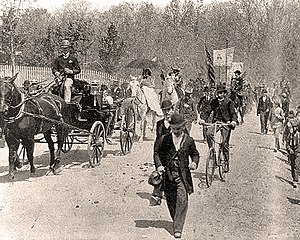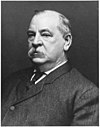Coxey's Army

Coxey's Army was a protest march by unemployed workers from the United States, led by Ohio businessman Jacob Coxey. They marched on Washington, D.C., in 1894, the second year of a four-year economic depression that was the worst in United States history at the time. Officially named the Army of the Commonweal in Christ, its nickname came from its leader and was more enduring. It was the first significant popular protest march on Washington, and the expression "Enough food to feed Coxey's Army" originates from this march.
First march[edit]
The purpose of the march, termed a "petition in boots",[1] was to protest the unemployment caused by the Panic of 1893 and to lobby for the government to create jobs which would involve building roads and other public works improvements, with workers paid in paper currency which would expand the currency in circulation, consistent with populist ideology. The march originated with 100 men in Massillon, Ohio, on March 25, 1894,[2] passing through Pittsburgh, Becks Run and Homestead, Pennsylvania, in April.[3]

The Army's western section received the nickname Kelley's Army, after California leader "General" Charles T. Kelley. Although larger at its beginning, Kelley's Army lost members on its long journey; few made it past the Ohio River. Another group, Fry's Army, began marching in Los Angeles, but largely dissipated east of St. Louis. Various groups from around the country gathered to join the march, and its number had grown to 500 with more on the way from further west when it reached Washington on April 30, 1894. The 260-acre (1.1 km2) Shreve farm site at current day Colmar Manor, Maryland, was used by the 6,000 jobless men as a camp site.[4] Coxey and other leaders of the movement were arrested the next day for walking on the grass of the United States Capitol. Interest in the march and protest rapidly dwindled.[5] Although it was ultimately unsuccessful, the march is notable as the first protest march on Washington, D.C.[1]
Some of the most militant Coxeyites were those who formed their own "armies" in Pacific Northwest centers such as Butte, Tacoma, Spokane, and Portland. Many of these protesters were unemployed railroad workers who blamed railroad companies, President Grover Cleveland's monetary policies, and excessive freight rates for their plight. The climax of this movement was perhaps on April 21, 1894, when William Hogan and approximately 500 followers commandeered a Northern Pacific Railway train for their trek to Washington, D.C.[citation needed] They enjoyed support along the way, which enabled them to fight off the federal marshals attempting to stop them. Federal troops finally apprehended the Hoganites near Forsyth, Montana. While the protesters never made it to the capital, the military intervention they provoked proved to be a rehearsal for the federal force that broke the Pullman Strike later that year.[6]
Second march[edit]

Coxey organized a second march in 1914.[7] A portion of the march reached Monessen, Pennsylvania, on April 30.[8] Another contingent from New York City merged with the march.[9] When the march reached Washington, D.C., Coxey addressed a crowd of supporters from the steps of the United States Capitol.[10]
Legacy[edit]
Although Coxey's proposal for government jobs was radical for its time, it came to be part of U.S. federal policy with the passing of the New Deal. On May 1, 1944, Coxey was asked to read his original petition from the steps of the Capitol. More significantly, marches on Washington became a popular way for people to express their displeasure at the government or various of its policies.[1]
Coxey's Army in culture[edit]

Among the people observing the march was L. Frank Baum, before he gained fame. There are political interpretations of his book, the Wonderful Wizard of Oz, which have often been related to Coxey's Army. In the novel, Dorothy, the Scarecrow (the American farmer), Tin Woodman (the industrial worker), and Cowardly Lion (William Jennings Bryan), march on the yellow brick road to the Emerald City, the Capital (or Washington, D.C.), demanding relief from the Wizard, who is interpreted to be the President. Dorothy's shoes (made of silver in the book, not the familiar ruby that is depicted in the movie) are interpreted to symbolize using free silver instead of the gold standard (the road of yellow brick) because the shortage of gold precipitated the Panic of 1893. In the film adaptation of The Wizard of Oz, the silver shoes were turned into ruby for the cinematic effect of color, as Technicolor was still in its early years when the movie was produced. However, this theory was not advanced until many decades after the book was written.[11]
The phrase Coxey's Army has also come to refer to a ragtag band, possibly due to an incident during the second march in 1914.[12]
Coxey's Army also plays a prominent role in Garet Garrett's The Driver, in which the main character is a journalist following the march.[citation needed]
In his story "Two Thousand Stiffs" (published in hardcover as part of the 1907 collection The Road), Jack London describes his experiences as a member of Kelley's Army. The story gives a vivid account on a personal level of the motivations of the unemployed "stiffs", the military style organization of their army, and the more and less willing support given them by more fortunate Americans who were still sympathetic to their cause. In London's description, he joined Kelley's Army at Council Bluffs, Iowa, and remained with it until its dissolution at the Mississippi River, a dissolution caused primarily by the inability to capture trains for transportation from an alerted railroad industry.[13]
In the 1955 play Inherit the Wind, Meeker (the jailer/bailiff) mentions Coxey's Army when talking to Rachel Brown in an early scene.[citation needed]
Coxey's Army's arrival in Washington, D.C., sets the backdrop of the 2016 historical murder mystery, A March To Remember, by Anna Loan-Wilsey (ISBN 978-1617737282).
The expression "Enough food to feed Coxey's Army" signifies that the person commenting believes there is a great deal more food being prepared or presented than is actually required for the persons to be fed.[14]
In the prologue to "On the Way Home," the diary of Laura Ingalls Wilder of her family's trip from De Smet, South Dakota, to Mansfield, Missouri, in 1894, there is mention of Coxey's armies. The prologue (and epilogue) to "On the Way Home" were written by Wilder's daughter Rose Wilder Lane, who was an accomplished and well-known writer long before her mother. Lane describes Coxey's armies as coming from California, seizing railroad trains as they headed East towards Washington, and terrorizing towns and pillaging for food on their route. Lane concluded, "In all the cities Federal troops were guarding the Government's buildings."[15]
See also[edit]
- Bonus Army, a July 1932 march on Washington, D.C.
- Fry's Army, an earlier 1894 effort to march to Washington, D.C.
- Carl Browne, a top leader of the Coxey's Army march
- James Renshaw Cox, leader of a January 1932 march on Washington, D.C.
- List of rallies and protest marches in Washington, D.C.
Footnotes[edit]
- ^ a b c Grinspan, Jon (May 1, 2014). "How a Ragtag Band of Reformers Organized the First Protest March on Washington, D.C." Smithsonian. Smithsonian Institution. Retrieved April 29, 2019.
- ^ "In Dreams He Sees An Army" (PDF). New York Times (March 25). 1894. Retrieved November 12, 2008.
- ^ "Coxey has a new commissary" (PDF). New York Times (April 6). 1894. Retrieved November 12, 2008.
- ^ "R.A. Shreve, Of Old Md. Family, Dies," The Washington Post May 8, 1951, pg. B2.
- ^ "Coxey's Army Dwindling Away" (PDF). New York Times (May 11). 1894. Retrieved November 12, 2008.
- ^ White, W. Thomas (July 1985). "Race, Ethnicity, and Gender in the Railroad Work Force: The Case of the Far Northwest, 1883–1918". The Western Historical Quarterly. 16 (3). The Western Historical Quarterly, Vol. 16, No. 3: 269–271. doi:10.2307/969128. JSTOR 969128.
- ^ "Gen. Coxey to Lead Unemployed Army" (PDF). New York Times (February 26). 1914. Retrieved November 12, 2008.
- ^ "Chronology of Monessen 1907–1920". Archived from the original on April 2, 2007. Retrieved December 6, 2008.
- ^ "Tramps to March on May 1; J. Eads Howe's Contingent Plans to Join Coxey's Army" (PDF). New York Times (April 13). 1914. Retrieved December 6, 2008.
- ^ Muller, John; November 29, 2018. "Wall Street isn't DC's first 'occupation'". Greater Greater Washington. Retrieved April 29, 2019.
{{cite web}}: CS1 maint: numeric names: authors list (link) - ^ Jahangir, Rumeana (March 17, 2009). "Secrets of the Wizard of Oz". BBC. Retrieved March 18, 2009.
- ^ "Trade Fifes for Beer. Coxey's Army Bandsmen Then Go To Jail For Intoxication" (PDF). New York Times. No. April 19. 1914. Retrieved November 13, 2008.
- ^ Jack London, The Road, Rutgers University Press, New Brunswick, 2006
- ^ Anders, Smiley (November 20, 2016). "Smiley: Thoughts on a draining experience". The Advocate. Retrieved April 28, 2018.
- ^ Wilder, Laura Ingalls, 1867–1957. (1962). On the way home : the diary of a trip from South Dakota to Mansfield, Missouri, in 1894. Lane, Rose Wilder, 1886–1968. New York: Harper & Row. ISBN 0-06-026490-X. OCLC 493117.
{{cite book}}: CS1 maint: multiple names: authors list (link) CS1 maint: numeric names: authors list (link)
Further reading[edit]
- Benjamin F. Alexander, Coxey's Army: Popular Protest in the Gilded Age, Baltimore, MD: Johns Hopkins University Press, 2015
- Franklin Folsom, Impatient Armies of the Poor: The Story of Collective Action of the Unemployed, 1808–1942. Niwot, CO: University Press of Colorado, 1991.
- Donald L. McMurry, Coxey's Army: A Study of the Industrial Army Movement of 1894. [1929] Seattle, WA: University of Washington Press, 1968.
- Jerry Prout, Coxey’s Crusade for Jobs: Unemployment in the Gilded Age (Northern Illinois University Press, 2016). 152 pp.
- Carlos A. Schwantes, Coxey's Army: An American Odyssey. Lincoln: University of Nebraska Press, 1985.
- Henry Vincent, The Story of the Commonweal: Complete and Graphic Narrative of the Origin and Growth of the Movement: Similar Movements in History – The March – Portraits of the Leaders – Other Pictures – The Objects Sought. Chicago: W.B. Conkey Co., 1894.
External links[edit]
- Daily Bleed Calendar: March 25, 1894
- "Recollections of a contingent of Coxey's Army passing through Straughn, Indiana, in April of 1894," poem by Jared Carter.
- "Coxey's Army" tribute song to Jacob Coxey and his march for jobs and justice, written by Joe DeFilippo and performed by the R.J. Phillips Band


